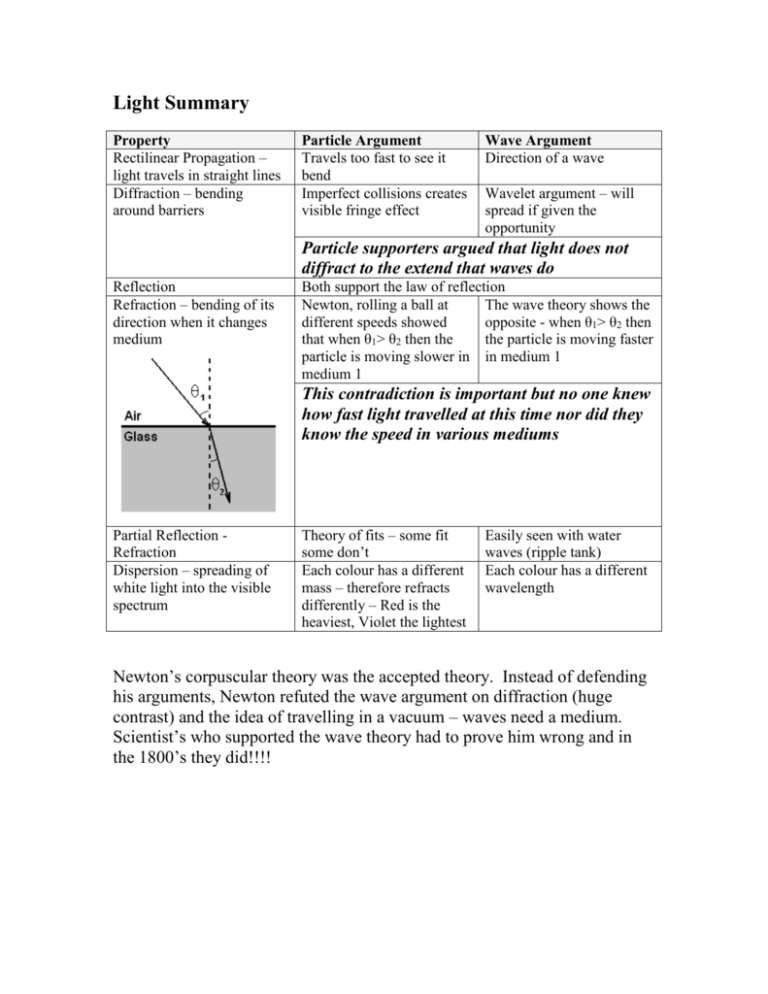Light Summary
advertisement

Light Summary Property Rectilinear Propagation – light travels in straight lines Diffraction – bending around barriers Particle Argument Travels too fast to see it bend Imperfect collisions creates visible fringe effect Wave Argument Direction of a wave Wavelet argument – will spread if given the opportunity Particle supporters argued that light does not diffract to the extend that waves do Reflection Refraction – bending of its direction when it changes medium Both support the law of reflection Newton, rolling a ball at The wave theory shows the different speeds showed opposite - when θ1> θ2 then that when θ1> θ2 then the the particle is moving faster particle is moving slower in in medium 1 medium 1 This contradiction is important but no one knew how fast light travelled at this time nor did they know the speed in various mediums Partial Reflection Refraction Dispersion – spreading of white light into the visible spectrum Theory of fits – some fit some don’t Each colour has a different mass – therefore refracts differently – Red is the heaviest, Violet the lightest Easily seen with water waves (ripple tank) Each colour has a different wavelength Newton’s corpuscular theory was the accepted theory. Instead of defending his arguments, Newton refuted the wave argument on diffraction (huge contrast) and the idea of travelling in a vacuum – waves need a medium. Scientist’s who supported the wave theory had to prove him wrong and in the 1800’s they did!!!! Young’s Double slit Experiment (1804) – Showed that light has a wavelength – Red has the longest, violet the shortest. The colours were visible due to the interference of light waves – a definite wave property of light. Foucault (1850) showed that light travelled slower in water than air. This solved the contradiction about refraction. Light refracts like a wave. Polarization effects – light can be reduced to a single vibrational plane with polarizing filters (crystals) (mid 1800’s) also supporting the wave theory. Maxwell’s equations (1864) relating Electricity and Magnetism provides a way that waves can travel in a vacuum but as the video indicated, Maxwell was not well understood and this fact was not connected at the time. Aside – Poisson’s Bright Spot – A wave supporter name Augustin Fresnal – in 1819 devised equations supporting the wave theory of light. Simon Poisson, a particle supporter argued against the equations stating that if they were correct, a bright spot should appear at the center of a shadow around a circular disk. In an attempt to prove Fresnal wrong, a bright spot was noticed and it became known as Poisson’s Bright Spot. Further Wave support – colour distortions in soap bubbles can be easily explained through the interference of waves. Partial reflection refraction occurs at each medium change and the splitting of the wave creates a path difference. When these waves experience further medium changes, the resulting interference creates both constructive and destructive interference – creating different colours. To solidify the wave theory of light, scientists had to show how a wave could travel in a vacuum. This led to the famous Michelson and Morley experiment (1887) using an interferometer. The conclusion became famous by Einstein – that the speed of light is ABSOLUTE.





